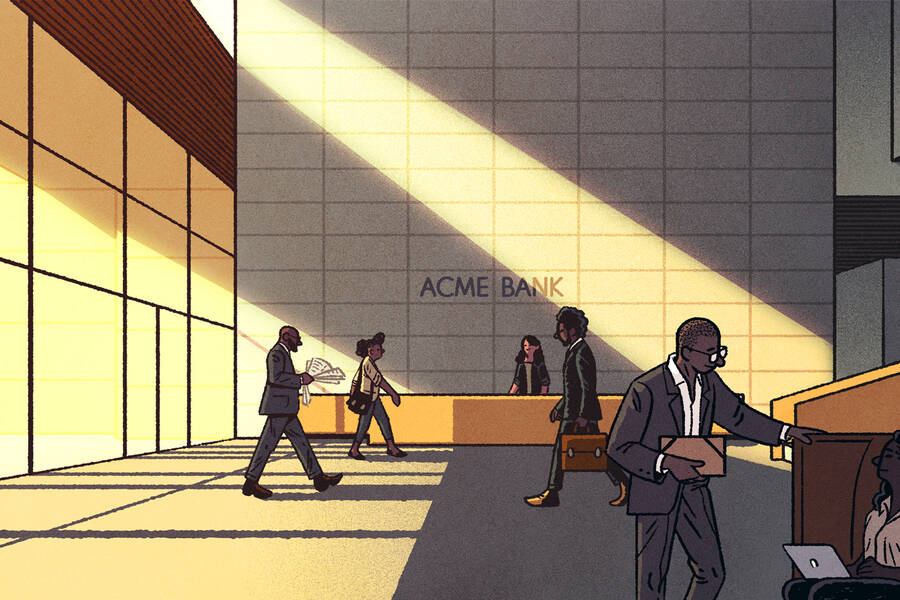Social Impact Finance & Accounting Policy Jan 2, 2024
Community Revitalization Is Hard to Get Right. Here’s How It Can Succeed.
“The basic amenities people want are pretty universal, but every community has its own priorities and ideals.”

Michael Meier
Whether it goes by “urban renewal,” “neighborhood transformation,” or “community reinvestment,” the effort to make American cities prosperous and equitable is among the central challenges of the post-pandemic recovery.
The goals of these initiatives are usually clear enough: affordable housing, good education, public safety, commercial growth, and sustainable development. The challenge is how to achieve these goals without displacing residents or compromising a neighborhood’s traditional identity—a challenge shared by city officials, real estate developers, and community organizers.
“It’s always a balance,” says William Towns, an adjunct professor of social impact at Kellogg and the National Market President for Community Revitalization and Public Housing for Gorman & Company, a national development firm that focuses on community revitalization.
Towns works with city housing authorities, community leaders, and city officials to develop plans to redevelop communities utilizing innovative financial tools such as “opportunity zones,” where companies have a tax incentive to expand commercial activities, and programs including the U.S. Department of Housing and Urban Development’s (HUD) Rental Assistance Demonstration program, which is designed to address the issue of aging public housing infrastructure.
But redeveloping a community is easier said than done, he says.
“One of the biggest challenges I have observed is a community’s fear of gentrification,” Towns says. “People rightfully want better housing stock, improved schools, new retail amenities, safer neighborhoods, and stronger connections to public transportation, but do not want anyone else to know about it.”
Towns identifies three pieces of advice for making these initiatives more successful.
Listen to the community
Community reinvestment works best when new projects truly address the community’s own desires. This means involving them in a transparent dialogue even before the official planning process begins.
“The basic amenities people want are pretty universal, but every community has its own priorities and ideals of how those amenities should be delivered, so the process must be collaborative,” Towns says. “It’s never top-down. You’re rarely telling the community something they don’t already know, so dictating what needs to happen is often viewed as insulting and—at best—a waste of time. If the community doesn’t feel like they’re a part of the process, they will reject even a much-needed amenity.”
Ultimately, the people who live in the neighborhood are the ones who decide which amenities and services they are interested in and the kinds of business they will support. Without the support of the community, businesses or housing developments will fail.
So the job of anyone facilitating investment—whether a city official, developer, or community organizer—is to translate the community’s priorities into the language of development and policy. Part of that translation requires dealing with and mediating among different interest groups.
Take the redevelopment of Grove Parc Plaza. Originally built in the late 1960s to serve the low-income residents of Chicago’s Woodlawn community, by the turn of the century, the development was in such bad shape that HUD considered closing it before the Preservation of Affordable Housing, a nonprofit based in Boston, was selected to reimagine the project. The development had design flaws and concentrated poverty, and it was seen as a barrier to investment in the neighborhood, which created a spiral of disinvestment and increased crime.
“Larger institutions tend to create clustering effects that can bolster new development and send a strong signal to the market.”
—
William Towns
Through a long series of community listening sessions, which did not start off smoothly, Grove Parc was able to begin the transformation to incorporate new and renovated mixed-income housing, as well as the community’s first new full-service grocery store in the past 40 years. This has contributed to the growth of a healthier mixed-use, mixed-income community.
“If they listen carefully, take notes, and remain empathetic, community developers and policymakers will be able to grasp the underlying issues and desires,” Towns says. “For some projects, these conversations can surface as a lot of anger, disappointment, and confusion. But within all that, there are bits of truth. The challenge is sifting through it all and helping the community fine-tune the message. Because it needs to come from them.”
Respect the ecosystem
Too often, well-intentioned organizations and city officials try to jump-start development by focusing efforts too narrowly on one aspect of a community. But when organizations plan redevelopment components in relative isolation, the component itself may succeed, but the community may see little change from the current status.
If, for example, an initiative invests heavily in developing affordable housing in a community suffering from high crime, poorly preforming schools, and a lack of amenities, without a plan to address these issues, the housing initiative won’t revitalize the community.
“You have to be able to look at the whole ecosystem as you plan,” Towns says.
The challenge for community leaders, of course, is balancing a holistic approach, which treats the entire ecosystem, with the reality of limited resources and competing priorities.
“The key here is understanding that even a lack of resources—or competing priorities—don’t prevent you from signaling to the market that there is a clear and thoughtful plan in place to address the other areas of concern,” Towns says. “Residents, investors, business owners, and future community members need to be able to see how the ecosystem issues are being considered, because people rarely decide where they will live based on one thing.”
Thinking holistically about revitalization also involves getting ahead of displacement caused by rapid gentrification. In Pilsen, Chicago’s first majority-Latino community, property taxes soared as wealthier residents moved in, making it difficult for longtime owners and renters to stay. Or consider West Philadelphia. When the University of Pennsylvania invested in public secondary schools in that neighborhood—after working with local authorities to assess the community’s needs—the area grew so popular that it priced out legacy residents who had sought the schools in the first place.
“The community needs to understand that we are living in real time and that these things are fluid,” Towns says. “The goal is to come up with plans in conjunction with policies that enhance community goals while mitigating the unintended results of the needed investments.”
There are many tools that have been developed to help address the unintended consequences of the intentional act of community redevelopment. One such tool is the Anti-Displacement and Gentrification Toolkit Project developed by the Toulan School of Urban Studies and Planning at Portland State University. The primary objective of the project is to create a set of resources for local governments to use to mitigate the impacts of gentrification and displacement.
Another popular solution to the problem of displacement is the use of community land trusts. These nonprofits hold land on behalf of the community, often subsidizing housing purchase prices in exchange for capping the same homes’ future sell prices as a way to discourage speculative buyers. Trusts can also serve as stewards of community gardens, civic buildings, and other shared spaces. The Chicago Housing Trust, for example, works with city planners, community groups, and private developers to offer long-term affordable housing options to all residents.
“Whatever mitigation strategies a community ultimately lands on should be incorporated into the overall planning process,” Towns says.
Keep the momentum
Public–private developments that include retail corridors generally exist in precarious markets. This makes it crucial that city planners, investors, and residents all view the project as having the potential to succeed—and work to keep the momentum going.
A single new housing development or safe streets initiative is rarely enough to spur a lot of additional investment.
“It’s not a one-and-done problem,” Towns says. “It’s great when the prodigal person returns to a community and gives back to the neighborhood. But how can that that investment be leveraged with other existing initiatives—or must we create new ones—to take advantage of the current situation? An announcement is not the end but just the start.”
This is one reason why major institutions tend to play an outsized role in shoring up confidence for neighborhood revitalization plans. If a large company or university decides to expand into a disinvested community, for instance, others are more inclined to follow, helping the project achieve a critical mass.
“Larger institutions tend to create clustering effects that can bolster new development and send a strong signal to the market,” Towns says. The Obama Presidential Center is one recent example of this in Chicago. “Given the historic nature of Obama’s presidency, the center has the potential to attract a global audience with hundreds of thousands of visitors a year, spurring the need for new restaurants, gift shops, and community tour companies, as well as new market-rate and affordable housing developments.”
But it is also important to ensure that a development’s new businesses stay open. In the end, this means that members of the community must patronize the new shops and restaurants.
“I often tell community groups, ‘If you’re saying these are the amenities you want, then it is imperative that you support them,’” says Towns. “In an established neighborhood, a storefront may change every six months as demand for retail space is strong. But in disinvested neighborhoods, when a store closes, it could be ten years before another business comes back.”
This, in turn, reinforces Towns’ original point about investors doing their homework to ensure that they build amenities that the community wants to support. Getting this part wrong can torpedo the entire revitalization effort.
“There is no greater setback in an underinvested community than a new business going out of business,” Towns says. “The market looks at these signals and might decide, ‘This is an area that cannot support a business.’”
Andrew Warren is a writer based in Southern California.



